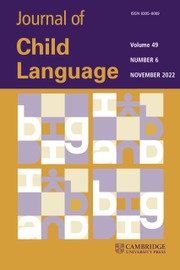Article contents
Cumulative semantic interference across unrelated responses in school-age children's picture naming
Published online by Cambridge University Press: 03 September 2020
Abstract
Naming semantically related images results in progressively slower responses as more images are named. There is considerable documentation in adults of this phenomenon, known as cumulative semantic interference. Few studies have focused on this phenomenon in children. The present research investigated cumulative semantic interference effects in school-aged children. In Study 1, children named a series of contiguous, semantically related pictures. The results revealed no cumulative interference effects. Study 2 utilized an approach more closely aligned with adult methods, incorporating intervening, unrelated items intermixed with semantically related items within a continuous list. Study 2 showed a linear increase in reaction time as a function of ordinal position within semantic sets. These findings demonstrate cumulative semantic interference effects in young, school-aged children that are consistent with experience-driven changes in the connections that underlie lexical access. They invite further investigation of how children's lexical representation and processing are shaped by speaking experiences.
Information
- Type
- Article
- Information
- Copyright
- Copyright © The Author(s), 2020. Published by Cambridge University Press
References
- 1
- Cited by


